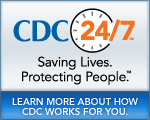MMWR
Morbidity and Mortality Weekly Report
Synopsis for March 6, 2008
- Self-Reported Falls and Fall-Related Injuries Among Persons Aged >65 Years — United States, 2006
- Cost of Vaccinating Refugees Overseas Versus After Arrival in the United States, 2005
- U.S.-Incurred Costs of Wild Poliovirus Infections in a Camp with U.S.-Bound Refugees — Kenya, 2006
There is no MMWR telebriefing scheduled for:
March 6, 2008
Self-Reported Falls and Fall-Related Injuries Among Persons Aged >65 Years — United States, 2006
PRESS CONTACT: CDC
National Center for Injury Prevention and Control
Media Relations
(770) 488-4902
Fall-related injuries can seriously affect older adultsa€? quality of life and are a significant burden to our health care system. To help older adults lead independent, healthy lives, CDC has developed two publications that provide scientifically proven fall interventions to help reduce these deaths and injuries. Falls among older adults are a serious public health problem. CDCa€?s 2006 Behavioral Risk Factor Surveillance System (BRFSS) provides the national estimates of fall-related injuries among people 65 years and older. Researchers found that an estimated 5.8 million older adults (15.9 percent) reported falling at least once in the previous three months and 1.8 million people reported sustaining some type of fall-related injury requiring a doctor visit or restricted activity for at least a day. These injuries have a serious impact on the quality of life of older adults and on our health care system. It also reinforces the need to raise awareness and provide scientifically proven fall prevention interventions. To help older adults live to their full potential CDC is releasing two free publications entitled: Preventing Falls: What Works. A Compendium of Effective-Community Based Interventions From Around The World and Preventing Falls: How to Develop Community-based Falls Prevention Programs for Older Adults. Both publications are available at http://www.cy118119.com/ncipc/preventingfalls/.
Cost of Vaccinating Refugees Overseas Versus After Arrival in the United States, 2005
PRESS CONTACT: CDC
Division of Media Relations
(404) 639-3286
A recent study conducted by CDC's Immigrant, Refugee and Migrant Health Branch found that vaccinating refugees overseas could result in a significant cost reduction and savings, prevent importation of disease into the U.S., and reduce human suffering. This study compared the costs of vaccinating refugees overseas versus after their arrival in the United States. The results suggest that vaccinating refugees in the United States would have cost three times as much as overseas, approximately $26.0 million versus $7.7 million. In addition to cost savings, overseas vaccination has the potential to reduce importation of diseases, thereby protecting the health of the U.S. population and reducing costs associated with response to outbreaks. To achieve public health cost savings, routine overseas vaccination of U.S.-bound refugees should be considered.
U.S.-Incurred Costs of Wild Poliovirus Infections in a Camp with U.S.-Bound Refugees — Kenya, 2006
PRESS CONTACT: CDC
Division of Media Relations
(404) 639-3286
Vaccinating refugees overseas could result in a significant cost reduction and savings to the U.S., prevent importation of disease into the U.S., and reduce human suffering. This report describes costs incurred by the U.S. government and U.S. funded organizations from a response to an outbreak of poliomyelitis in a Kenyan camp occupied by refugees undergoing resettlement to the United States. Requiring routine pre-departure vaccinations for U.S.-bound refugees might decrease the small risk of polio importation, result in cost savings to the U.S., and prevent illness and suffering.
####
- Historical Document: March 6, 2008
- Content source: Office of Enterprise Communication
- Notice: Links to non-governmental sites do not necessarily represent the views of the CDC.
View Press Releases in
Get e-mail updates
To receive e-mail updates about this page, enter your
e-mail address:
Contact Us:
- Centers for Disease Control and Prevention
1600 Clifton Rd
Atlanta, GA 30333 - 800-CDC-INFO
(800-232-4636)
TTY: (888) 232-6348 - Contact CDC-INFO


